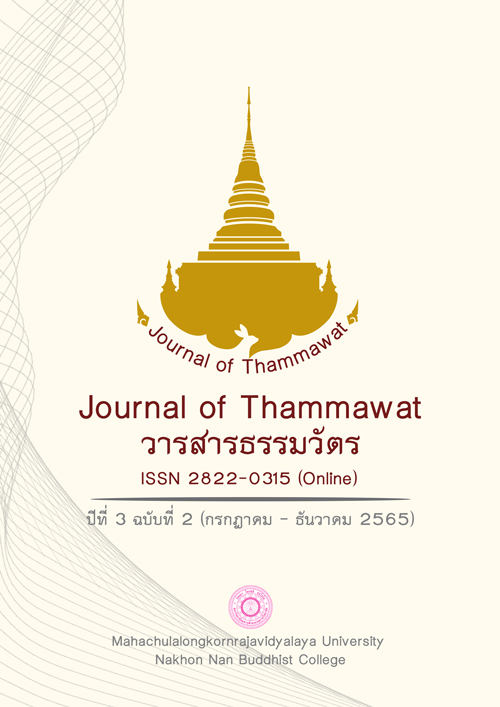Buddhist Art of Laikham for Learning: The Value of Inheritance in Lanna Style
Main Article Content
Abstract
This study was creative research which collected the information about Laikam Lanna artwork and the purposes of this study were: 1. To examine knowledge, value, patterns of Laikam Lanna artwork. 2. To examine the process of creating Laikam Lanna artwork. 3. To transfer knowledge, value and beauty of Laikam Lanna artwork by exploring Laikam Lanna artwork at various temples in the 3 upper northern provinces of Thailand which are: 1. Chiang Rai Province: Wat Phra Singh 2. Chiang Mai Province: Wat Phra Singh Woramahaviharn 3. Lampang Province: Wat Phra That Lampang Luang
The findings showed that; there was no evidence showed when the traditional Laikam Lanna artwork had appeared. However, Laikam Lanna artwork was categorized in the category of Lacquered artwork through the oldest evidence that the Lacquered artwork had its origins in ancient China during the Han Dynasty and the Chinese knew how to work in Lacquered artwork before other nations. On the other hand, Thai lacquered gilding artwork appeared since the Ayutthaya period which could be influenced by ancient Chinese artwork.
The Lanna Kingdom was one kingdom in the north and later be collected as a part of Thailand therefore Lanna artwork had been influenced by Thai lacquered gilding artwork before developed into Laikam Lanna artwork. The finished of Thai lacquered gilding artwork and Laikam Lanna artwork had similar characteristics but had some slightly different in the techniques. Laikam Lanna artworks normally were Pruksa patterns (Flower pattern), Kankhot patterns and Jataka images gild on red and black background. Normally appeared on doors, windows, pillars, crossbars, ceilings, walls inside Buddhist monasteries and Buddha image halls including the Tripitaka cabinets, the arks of the dharma, the pulpits, the palm leaf books and variety of appliances. Laikam Lanna artwork had 4 techniques creating lacquered gilding designs which were: Technique 1: Stenciling with gilding which was to template stencil pattern on paper and cut then place on the area that had already lacquered and then gilde on the stencil pattern paper that was placed. Technique 2: Stenciling with gilding and bold the line which was the technique that developed from technique 1 by cut the line of design and add details in the design to make the work more finely detailed and cleared. Technique 3: Stenciling with gilding and inscribing which was the technique that developed from technique 1 by drawing more detail on the gold gilding area by sharp metal also, known as “Inscribing”. Technique 4: Gold appliqué on black lacquer which was drawing the design on black lacquer with Realgar color then slightly cover with black lacquer and clean the left-over gold leaves with water.
The knowledge which had gained from the research of Laikam Lanna Buddhist artwork was disseminated through teaching and applied to Laikam Lanna's contemporary artwork which could help to preserve, inherit and develop traditional Laikam Lanna artwork as well as to preserve the value and further disseminate traditional Lanna Buddhist artwork.
Article Details

This work is licensed under a Creative Commons Attribution-NonCommercial-NoDerivatives 4.0 International License.
References
ขุนเพชร ขุนราม. (2560). ลายคำ. สืบค้นเมื่อ 15 ธันวาคม 2562, จาก www.bloggang.com/m/ viewdiary.
ถาวร ฟั่นชมพู. (2553). กรณีศึกษาจิตรกรรมฝาผนัง ในจังหวัดเชียงใหม่ ระหว่างพุทธศตวรรษที่ 20-24 ด้วยกระบวนการทางคอมพิวเตอร์กราฟฟิก. เชียงใหม่: มหาวิทยาลัยเทคโนโลยีราชมงคลล้านนา.
พระพรหมคุณาภรณ์ (ป.อ.ปยุตฺโต). (2554). แก่นแท้ของพระพุทธศาสนา. กรุงเทพฯ: อักษรสัมพันธ์.
สุรพล ดำริห์กุล. (2560). งานศิลปะลายคำในลำปาง. สืบค้นเมื่อ 16 ธันวาคม 2562, จาก http://www.lampang.go.th/travel/weblt/page/page4.html.
สันติ เล็กสุขุม. (2533). จิตรกรรมแบบประเพณีและแบบสากล. กรุงเทพฯ: มหาวิทยาลัยสุโขทัยธรรมาธิราช.
สุวิภา จำปาวัลย์ และ ชัปนะ ปิ่นเงิน. (2553). การศึกษาพุทธสัญลักษณ์ล้านนา. เชียงใหม่: สถาบันวิจัยสังคม มหาวิทยาลัยเชียงใหม่.


